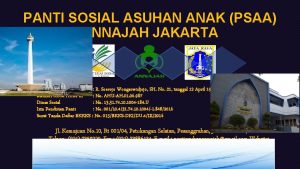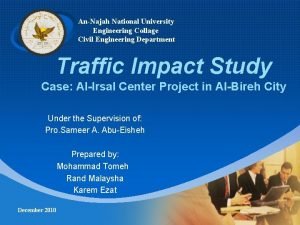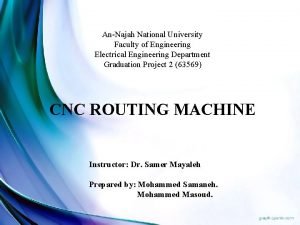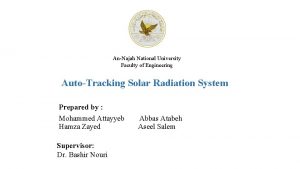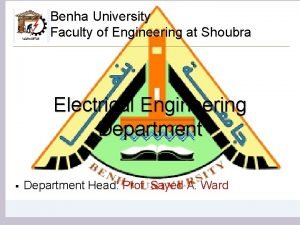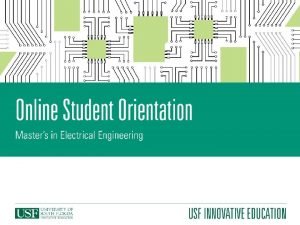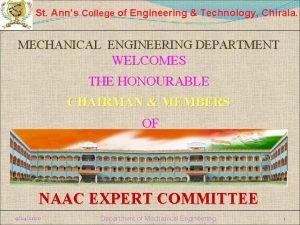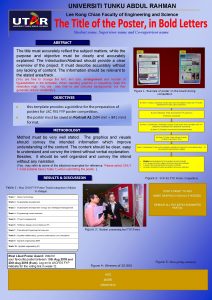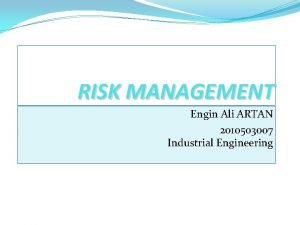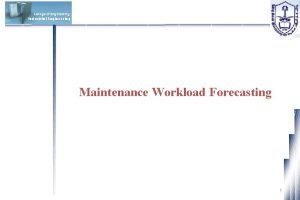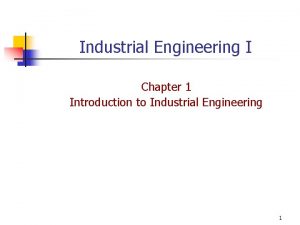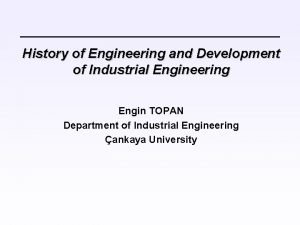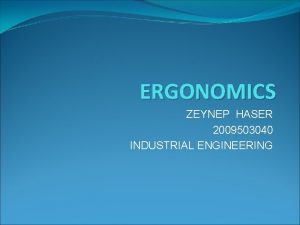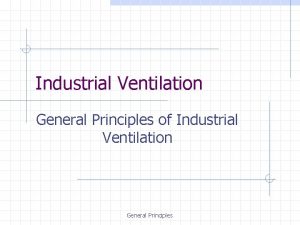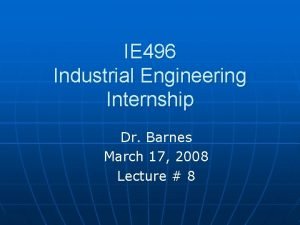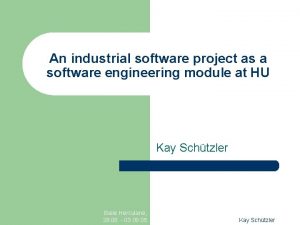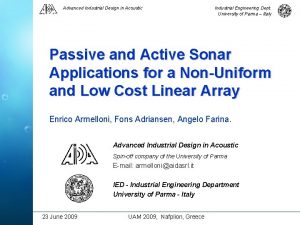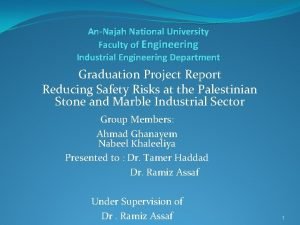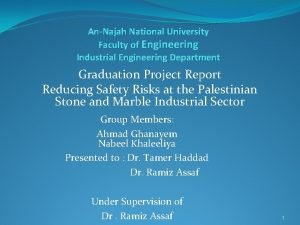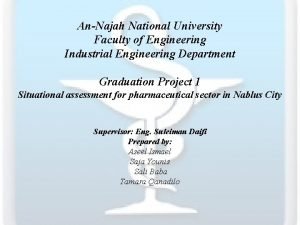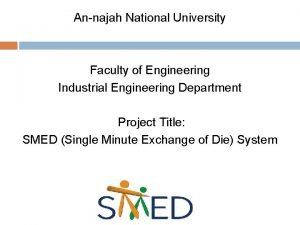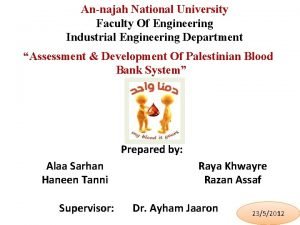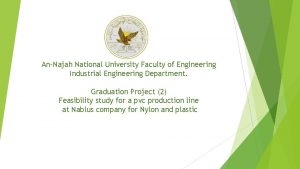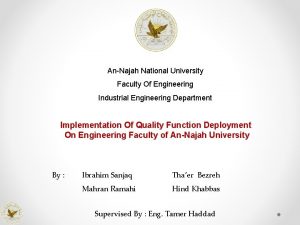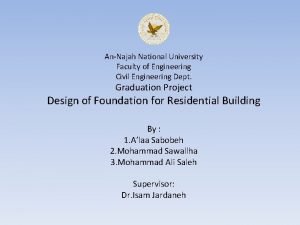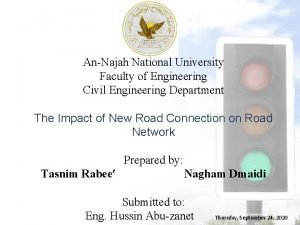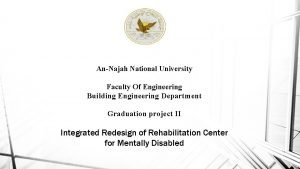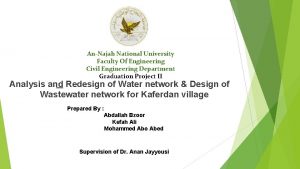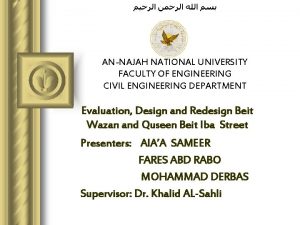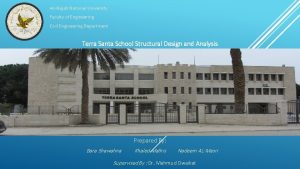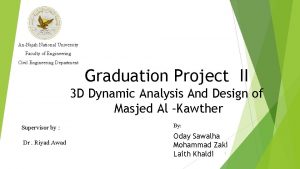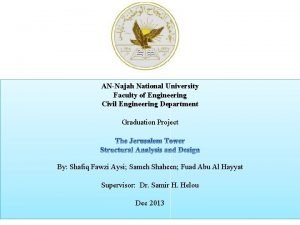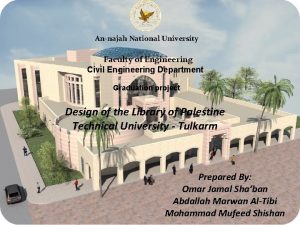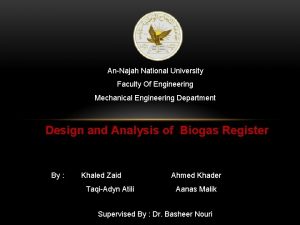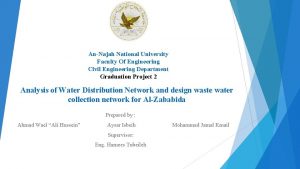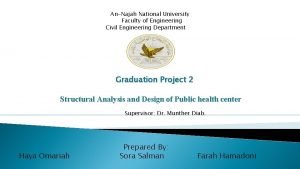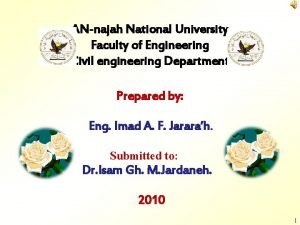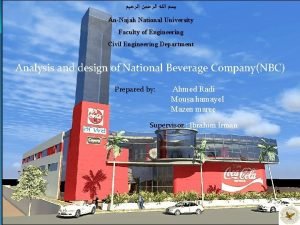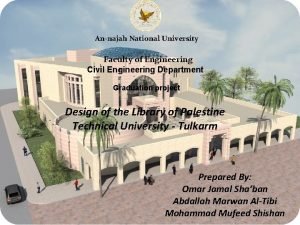ANNajah National University Faculty of Engineering Industrial Engineering



































































- Slides: 67

AN-Najah National University Faculty of Engineering Industrial Engineering Department Supervisor : Dr. Ayham Jaaron

MAIN SECTIONS IN PRESENTATION section 1 • Introduction Section 2 • Literature review Section 3 • Initial assessment Section 4 Section 5 • Transportation system development • Conclusion & Recommendation

Sectio n 1 Introductio n

Sectio n 1 Introductio n WHAT IS TRANSPORTATION? Is the movement of people and goods from one place to another depending on or using different types of vehicles.

Sectio n 1 Introductio n TRANSPORTATION TYPES

Sectio n 1 Introductio n PUBLIC TRANSPORTATION Transportation system is considered as a basic vein which helps in travelers’ movement from one point to another in any country.

Sectio n 1 Introductio n THE IMPORTANCE OF TRANSPORTATION Transportation system is not only a civilization front part but it also ties up different parts and cities in our homeland, supports all kinds of social, agriculture, cultural and commercial exchange and promotes different kinds of tourism which increase investment chances and the economical revival.

Sectio n 1 Sectio n 2 Introduction literature review

Sectio n 2 literature review In this chapter there are eight main sections: 12345678 - Route location. Basic speed/Fleet size relationships. Transit scheduling. Transit demand analysis. Cost analysis. Human factors and safety in Transportation. Design of land transportation terminals. Surveying.

Sectio n 2 literature review 1 - Route location. -Basic principles. -Information sources for transit route analysis. -Routing patterns. -Considerations in route location. -Route location guidelines. -New service.

Sectio n 2 literature review 2 - Basic speed/Fleet size. -Average speed. -fleet size as determined by demand. -Vehicle hour , Vehicle mile.

Sectio n 2 literature review 3 - Transit scheduling. - Data needs.

Sectio n 2 literature review 4 - Transit demand analysis. -Relation to service design. -Market size. -Market share.

Sectio n 2 literature review 5 - Cost analysis. -Cost determination. -Cost allocation model.

Sectio n 2 literature review 6 - Human Factors and Safety in Transportation.

Sectio n 2 literature review 7 - Design of land transportation terminals. -Queuing theory. -Location and layout of parking.

Sectio n 2 literature review 8 - surveying - Origin_ destination survey

Section 1 Introduction Section 2 literature review Sectio n 3 Initial assessmen t

Sectio n 3 Initial assessme nt WEST BANK

Sectio n 3 Initial assessme nt TRANSPORTATION IN PALESTINE The Palestinian transportation system was clearly neglected, so that it was not easy to keep up with other transportation systems all around the world or even in our area.

Sectio n 3 Initial assessme nt TRANSPORTATION IN PALESTINE - transportation system in Palestine covers only 69% of the needs.

Sectio n 3 Initial assessme nt TRANSPORTATION The transport sector in Palestine "West Bank" subject to the supervision of the Ministry of Transport of Palestine. The most important priorities of the ministry is develop public transport, which reflects the pursuit of the ministry continued to regulate public transport, through the development of many of the strategic plans.

Sectio n 3 Initial assessme nt INDICATORS 1 - Road Network: which 4, 389. 3 km in the West Bank. 2 - High rate of private car ownership :

Sectio n 3 Initial assessme nt INDICATORS 3 - accidents Percent of Injured Type Modeate Injured 15% Seriously Fatally Injured 3% 2% Slightly Injured 80%

Sectio n 3 INDICATORS Initial assessme nt 5 - Population population 2007 -2016 3 000 2 500 000 2 000 1 500 000 Series 1 1 000 500 000 " " 01 6 "2 01 5 " 01 4 "2 " 01 3 "2 01 2 "2 1" " 01 0 "2 01 " "2 " 00 9 "2 00 8 "2 "2 00 7 " 0

Sectio n 3 Initial assessme nt MAIN PROBLEMS The main problems in Palestinian public transport: 1 – occupation. 2 - laws that limit the Ministry's work in the field of public transport. 3 - Infrastructure. 4 - Existing network lacks the stops and bus stations. 5 - Poor oversight role of the Ministry. 6 - Lack of cooperation from the owners of companies and owners of the buses with the Ministry. 7 - The lack and adequate financial support.

Sectio n 3 Initial assessme nt FACTS Transport system in West Bank suffers from: 1 - Lack of planning, development and regulation. 2 - High volume rate of private car ownership. 3 -High rate of accidents and injury. 4 - High population growth rates in The Palestinian territories. 5 -There is no plan with actual steps to regulate the transport sector.

Section 1 Introduction Section 2 literature review Section 3 Initial assessment Sectio n 4 Transportatio n system development

Section 4 Transportation system development ROUTE LOCATION Depending on shortest path method in “OR” and other considerations that be listed in literature review. All Routes in West Bank. All possible Routes between cities. Route location set as in the Map.

Section 4 Transportation system development ROUTE LOCATION After determining Route location Bus stops set in each city. For example Nablus city map.

Section 4 Transportation system development BASIC SPEED/ FLEET SIZE In this section the fleet size in each Route will be calculated. the main items that become to calculate is:

Section 4 Transportation system development BASIC SPEED/ FLEET SIZE 1 - Cycle time : is the time for one vehicle to make a complete cycle of the route. 2 - Required headway 3 - The number of vehicles (NV) needed to service a route with a given length (L).

Section 4 BASIC SPEED/ FLEET SIZE Transportation system development Results for Nablus – Tulkarm Route Category Result Cycle time 4. 567 hr Headway 437. 5 minutes 125 vehicle/ 68 NV served

Section 4 BASIC SPEED/ FLEET SIZE Transportation system development Qalqilia – Tulkarm : Category Result Cycle time 4. 06 hr Headway 387. 69 minutes 30 vehicle / 16 NV served

Section 4 Transportation system development BASIC SPEED/ FLEET SIZE Qalqilia – Ramallah: Category Result Cycle time 3. 799 hr Headway 434. 48 minutes 20 vehicle / 20 NV served

Section 4 Transportation system development BASIC SPEED/ FLEET SIZE Qalqilia – Nablus : Category Result Cycle time 3. 304 hr Headway 462. 5 67 vehicle/ 50 NV served

Section 4 BASIC SPEED/ FLEET SIZE Transportation system development Jenin – Nablus : Category Result Cycle time 1. 144 hr Headway 953. 932 minutes 17 vehicle / 36 NV served

Section 4 Transportation system development BASIC SPEED/ FLEET SIZE Jenin – Tulkarm : Category Result Cycle time 1. 599 hr Headway 980 minutes 13 vehicle/ 14 NV served

Section 4 Transportation system development TRANSIT SCHEDULING This section aims to set the best schedule in each Route : Nablus-Tulkarm Route select to explain the method of scheduling: 1 - Collecting data. 2 - Data analysis to reach bets schedule.

Section 4 TRANSIT SCHEDULING Transportation system development Jenin _Nablus : From-To Until 10 AM – 3 PM 6 6: 16 +16 9: 44 10 10: 24 10: 48 +24 3 P M 5 5: 19 +19 10: 24 10: 48 +24 3 P M Jenin-Nablus-Jenin From-To Jenin-Nablus-Jenin 10 3 PM – 5 PM 3: 27 3: 54 +27 5 5

Section 4 TRANSIT SCHEDULING Transportation system development Ramallah _Jenin : From-To Until 10 AM – 3 PM 6 6: 30 +30 5 5: 36 +36 9: 30 10 10: 36 11: 12 +36 3 PM 10: 37 11: 14 +37 3 PM Jenin-Ramallah-Jenin From-To 10 3 PM – 5 PM Jenin-Ramallah Not Feasible Ramallah-Jenin

Section 4 TRANSIT SCHEDULING Transportation system development Jenin _ Tulkarm: From-To Until 10 AM 6 6: 36 +36 Jenin-Tulkarm 5: 19 +36 Tulkarm-Jenin 10 3 PM – 5 PM 3: 36 4: 12 +36 Jenin-Tulkarm 5 3: 37 Tulkarm-Jenin +38 3 PM 10: 38 11: 16 +38 3 PM 10 5 From-To 10 AM – 3 PM 10: 38 11: 16 4: 14 +37 5

Section 4 TRANSIT SCHEDULING Transportation system development Qalqilia _Tulkarm: From-To Until 10 AM 6 6: 17 +17 Qalqilia-Tulkarm 10 5 5: 12 +12 10 Tulkarm-Qalqilia 10 3 PM – 7 PM 3 3: 2 +20 0 Qalqilia-Tulkarm From-To 3 Tulkarm-Qalqilia 3: 1 9 10 AM – 3 PM 10 10: 1 +11 3 PM 1 7 +19 7 10: 1 +13 3 PM 3

Section 4 TRANSIT SCHEDULING Transportation system development Qalqilia _Ramallah: From-To Until 10 AM 6 6: 20 10 AM – 3 PM +20 Qalqilia-Ramallah 5: 16 +16 Ramallah-Qalqilia-Ramallah-Qalqilia 10: 23 +23 3 PM 10 10: 29 +29 3 PM 10 5 From-To 10 10 3 PM – 7 PM 3: 27 3: 54 +31 7 7

Section 4 TRANSIT SCHEDULING Transportation system development Qalqilia _Nablus: From-To Until 10 AM 6 6: 16 10 AM – 3 PM +4 Qalqilia-Nablus 5: 19 +8 Nablus-Qalqilia-Nablus-Qalqilia 10: 09 +9 3 PM 10 10: 11 +11 3 PM 10 5 From-To 10 10 3 PM – 7 PM 3 3: 14 +14 3 3: 17 +17 7 7

Section 4 Transportation system development HUMAN FACTORS AND SAFETY IN TRANSPORTATION

Transportation system development Section 4 HUMAN FACTORS AND SAFETY IN TRANSPORTATION Comfortable Uncomfortable Unacceptable 20 -22 16 -12 and 30 -35 <12 or >35 Ventilation (/hr/pass) >35 8 -20 <8 Humidity(%) 30 -70 30 -20 and 70 -80 <20 or >80 Vibration (mm/s) 0. 2 1. 2 3 Temperature () Lighting Depends greatly on activity: Rough seeing tasks: hallways, corridors, inactive, storage. 20 -30 lumens Casual seeing tasks: reception, washroom, service area 30 -40 lumens. ordinary seeing tasks: switchboard, conference, room lounges 120 -1000 lumens Difficult and critical tasks: offices, machines, shops, detail work areas, 2505000 lumens Noise (d. BA) <65 75 -85 >85 Accelerations (m/) 1 2 4 Jerk 0. 6 1 1. 5

Section 4 Transportation system development HUMAN FACTORS AND SAFETY IN TRANSPORTATION Time of departure arrival 5: 40 6: 10 68. 7 72. 2 3: 42 4: 11 73. 2 3: 35 4: 02 3: 37 Noise Average Decision 70. 6 70. 50 uncomfortable 78. 7 76. 8 76. 23 uncomfortable 75. 4 79. 2 80 78. 20 uncomfortable 4: 05 73. 6 68. 9 77. 8 73. 43 uncomfortable 10: 10 10: 35 66. 7 71. 4 72. 1 70. 07 uncomfortable 3: 55 4: 23 75. 6 78. 2 71. 3 75. 03 uncomfortable 3: 35 0: 00 71. 6 70. 8 65. 9 69. 43 uncomfortable

Section 4 Transportation system development HUMAN FACTORS AND SAFETY IN TRANSPORTATION

Section 4 Transportation system development HUMAN FACTORS AND SAFETY IN TRANSPORTATION

Section 4 Transportation system development HUMAN FACTORS AND SAFETY IN TRANSPORTATION

Section 4 Transportation system development HUMAN FACTORS AND SAFETY IN TRANSPORTATION

Section 4 Transportation system development DESIGN OF LAND TRANSPORTATION TERMINALS

Section 4 Transportation system development DESIGN OF LAND TRANSPORTATION TERMINALS

Section 4 Transportation system development DESIGN OF LAND TRANSPORTATION TERMINALS

Section 4 Transportation system development DESIGN OF LAND TRANSPORTATION TERMINALS

Section 4 Transportation system development DESIGN OF LAND TRANSPORTATION TERMINALS

Section 4 Transportation system development DESIGN OF LAND TRANSPORTATION TERMINALS

Section 4 Transportation system development DESIGN OF LAND TRANSPORTATION TERMINALS

Section 4 Transportation system development DESIGN OF LAND TRANSPORTATION TERMINALS

Section 4 Transportation system development DESIGN OF LAND TRANSPORTATION TERMINALS

Section 4 Transportation system development DESIGN OF LAND TRANSPORTATION TERMINALS

Section 4 Transportation system development DESIGN OF LAND TRANSPORTATION TERMINALS Queuing theory

Section 1 Introduction Section 2 Literature review Section 3 Initial assessment Section 4 Transportation system development Section 5 Conclusion & Recommendations.

Section 4 Conclusion & Recommendation s CONCLUSIONS

Section 4 Conclusion & Recommendation s RECOMMENDATIONS

 Panti asuhan annajah
Panti asuhan annajah Logo annajah
Logo annajah Annajah motors
Annajah motors Annajah motors
Annajah motors Feup university of porto
Feup university of porto Roumieh university
Roumieh university Clemson university electrical engineering
Clemson university electrical engineering Faculty of mechanical engineering thammasat university
Faculty of mechanical engineering thammasat university National taiwan university civil engineering
National taiwan university civil engineering Herszon kherson maritime college of merchant marine fleet
Herszon kherson maritime college of merchant marine fleet University of bridgeport engineering
University of bridgeport engineering University of bridgeport computer science faculty
University of bridgeport computer science faculty Hubert kairuki memorial university faculty of medicine
Hubert kairuki memorial university faculty of medicine Semmelweis university faculty of medicine
Semmelweis university faculty of medicine King abdulaziz university faculty of medicine
King abdulaziz university faculty of medicine Fsu cybersecurity major
Fsu cybersecurity major Mendel university faculty of business and economics
Mendel university faculty of business and economics Singularity university faculty
Singularity university faculty Semmelweis university faculty of medicine
Semmelweis university faculty of medicine Ascaris lumbricoides ova
Ascaris lumbricoides ova Charles university faculty of humanities
Charles university faculty of humanities Faculty of veterinary medicine cairo university logo
Faculty of veterinary medicine cairo university logo Faculty of law of the university of zagreb
Faculty of law of the university of zagreb University of montenegro faculty of law
University of montenegro faculty of law University of kragujevac faculty of technical sciences
University of kragujevac faculty of technical sciences University of cologne faculty of management
University of cologne faculty of management Leading university teacher
Leading university teacher Hacettepe university faculty of medicine
Hacettepe university faculty of medicine Brown university computer science faculty
Brown university computer science faculty Faculty of veterinary medicine - university of tehran
Faculty of veterinary medicine - university of tehran Semmelweis university faculty of medicine
Semmelweis university faculty of medicine York university concurrent education acceptance rate
York university concurrent education acceptance rate Faculty of economics and business debrecen
Faculty of economics and business debrecen Faculty of veterinary medicine cairo university
Faculty of veterinary medicine cairo university Mendel university faculty of business and economics
Mendel university faculty of business and economics Chronic meningitis
Chronic meningitis Mahidol university public health
Mahidol university public health Trypanosoma bruzi
Trypanosoma bruzi Faculty of education khon kaen university
Faculty of education khon kaen university Faculty of communication arts chulalongkorn university
Faculty of communication arts chulalongkorn university Cairo university faculty of veterinary medicine
Cairo university faculty of veterinary medicine Lee kong chian faculty of engineering and science
Lee kong chian faculty of engineering and science Faculty of civil engineering ctu prague
Faculty of civil engineering ctu prague Faculty of engineering shoubra
Faculty of engineering shoubra Usf learn
Usf learn Civil engineering faculty
Civil engineering faculty St ann's engineering college chirala faculty
St ann's engineering college chirala faculty Faculty of electrical engineering
Faculty of electrical engineering Hijjawi faculty for engineering technology
Hijjawi faculty for engineering technology Lee kong chian faculty of engineering and science
Lee kong chian faculty of engineering and science Andy fisher mun
Andy fisher mun Faculty of electrical engineering ljubljana
Faculty of electrical engineering ljubljana National industrial recovery act of 1933
National industrial recovery act of 1933 National industrial strategy
National industrial strategy Institute of industrial science the university of tokyo
Institute of industrial science the university of tokyo National unification and the national state
National unification and the national state Risk management in industrial engineering
Risk management in industrial engineering Forecasting industrial engineering
Forecasting industrial engineering Industrial engineering chapter
Industrial engineering chapter Industrial engineering formal definition
Industrial engineering formal definition Define ergonomics in industrial engineering
Define ergonomics in industrial engineering Keizen event
Keizen event Cycle graph in method study
Cycle graph in method study Ndsu industrial engineering
Ndsu industrial engineering Industrial ventilation calculation
Industrial ventilation calculation Industrial engineering internship
Industrial engineering internship Industrial software engineering
Industrial software engineering Industrial design
Industrial design
